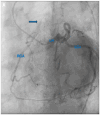An Uncommon Cause of Angina
- PMID: 40941728
- PMCID: PMC12428367
- DOI: 10.3390/diagnostics15172241
An Uncommon Cause of Angina
Abstract
Coronary anomalies, although rare, should be considered when young patients present with angina. Clinical suspicion and multi-modality imaging including coronary angiography and tomographic imaging should be pursued for symptomatic patients such as the one we are presenting with anomalous right coronary artery from the pulmonary artery. She was promptly referred for surgical intervention with re-implantation of the right coronary artery onto the aorta.
Keywords: angina; anomalous right coronary artery from the pulmonary artery (ARCAPA); chest pain; computed tomography; coronary angiography.
Conflict of interest statement
The authors declare no conflicts of interest.
Figures


References
-
- Vergara-Uzcategui C.E., das Neves B., Salinas P., Fernández-Ortiz A., Núñez-Gil I.J., Kunadian V., Kundi H., Rampat R., Milasinovic D., Sayers M., et al. Anomalous origin of coronary arteries from pulmonary artery in adults: A case series. Eur. Hear. J. Case Rep. 2020;4:1–5. doi: 10.1093/ehjcr/ytaa047. - DOI - PMC - PubMed
-
- Wesselhoeft H., Fawcett J.S., Johnson A.L. Anomalous origin of the left coronary artery from the pulmonary trunk. Its clinical spectrum, pathology, and pathophysiology, based on a review of 140 cases with seven further cases. Circulation. 1968;38:403–425. doi: 10.1161/01.CIR.38.2.403. - DOI - PubMed
LinkOut - more resources
Full Text Sources

